WHISPER OF THE HEART [1995]
Flash Gordon
(Anime Corner Staff Writer)
Pioneer Elite Plasma Display System PDP-5050SX
Denon AV Surround Receiver AVR-1801 with Dolby Digital/ DTS
Boston Acoustics Micro90T Die-Cast Surround Speakers including Subwoofer
Toshiba DVD SD-3755 Player with Dolby Digital/ DTS/ 3D Surround Sound.
MOTION PICTURE
PG RATING
A- ANIMATION
A- CHARACTER
- MECH DESIGN
A- MUSIC
A STORY
A- FILM GRADE
STUDIO: STUDIO GHIBLI
DIRECTOR: YOSHIFUMI KONDO
PRODUCER: TOSHIO SUZUKI/ STUDIO GHIBLI/ HAYAO MIYAZAKI
ANIMATOR: KITARO KOSAKA
DESIGNS: YOSHIFUMI KONDO/
SCRIPT: HAYAO MIYAZAKI
MUSIC: YUJI NOMI
THEME SONG: ‘TAKE ME HOME, COUNTRY ROADS’ [US opening theme] OLIVIA NEWTON-JOHN
‘COUNTRY ROAD’ [US closing theme] YOKO HONNA
DVD EXTRAS: BEHIND THE MICROPHONE WITH VOICE TALENT FROM THE FILM, INCLUDING BRITTANY SNOW, COURTNEY THORNE-SMITH, DAVID GALLAGHER AND CARY ELWES/ ORIGINAL STORYBOARDS/ TRAILERS AND TV SPOTS
|
| DVD BREAKDOWN |
Other Works Featuring Yoshifumi Kondo Include: |
| REVIEW (Warning:
Spoilers Ahead!) |
If you’ve heard of Yoshifumi Kondo it’s not surprising. If you haven’t, it’s understandable as his life was cut short unexpectedly by an aneurysm in January 1998. So it’s important to know a little about Kondo’s legacy. Directors Hayao Miyazaki and Isao Takahata formed Studio Ghibli in 1985 and Kondo was a key player in the studio’s animation development. He was a gifted talent who had a hand in many of the timeless classics that had been output by Studio Ghibli. As referenced on Nausicaa.net, Miyazaki eulogized at his funeral, “he was one of the best among the hundred of animators I ever met.” Takahata tearfully recalled indirectly addressing the late Kondo to the audience, “You always wanted to be positive… if you had not decided to work with me, there wouldn’t have been Grave Of The Fireflies or Only Yesterday.” The team player is how Kondo is remembered. He began as a character designer and animation supervisor on the television series Anne Of Green Gables [1979] [by Takahata prior to the formation of Studio Ghibli]. He was the animation supervisor and character designer for both Isao Takahata’s extraordinary Grave Of The Fireflies [1988] and later Only Yesterday [1991]. He was also animation director for Miyazaki on Kiki’s Delivery Service [1989] and animation supervisor on Princess Mononoke [1997]. In the midst of all of the important work being accomplished to credit and build the wondrous Studio Ghibli and the reputations of his greatest supporters Miyazaki and Takahata, he took the directorial reins to begin establishing a name for himself with his own Whisper Of The Heart [Mimi Wo Sumaseba] [1995]. He was easily one of the key directors/ animators/ advocates for Studio Ghibli alongside the masters and founders of the studio before passing at the tender age of 47 years.
Like Kiki’s Delivery Service, Whisper Of The Heart is a bewitching story of adolescence based on the manga by Aoi Hiiragi [a sequel manga, Happy Times [Shiawase No Jikan], followed]. Like any Studio Ghibli production it is overflowing with universal appeal. It is one of those rare films despite being animated that presents those difficult wonder years with genuine emotion, real dialogue and goes to the heart of those
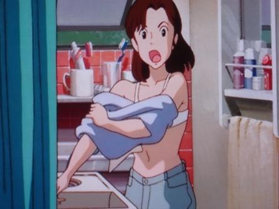 sentiments never striking a false note. The film is filled with all of the volatile feelings and tumultuous, gut-wrenching butterfly fluttering that will recollect your own teen years. Live-action films often fall short of sharing such insights into those trials and tribulations of youth opting instead for sophomoric distractions. Kondo does for Whisper Of The Heart’s coming-of-age tale what he did with Isao Takahata for the war story Grave Of The Fireflies. He brings the animation to life.
sentiments never striking a false note. The film is filled with all of the volatile feelings and tumultuous, gut-wrenching butterfly fluttering that will recollect your own teen years. Live-action films often fall short of sharing such insights into those trials and tribulations of youth opting instead for sophomoric distractions. Kondo does for Whisper Of The Heart’s coming-of-age tale what he did with Isao Takahata for the war story Grave Of The Fireflies. He brings the animation to life.
The star of Whisper Of The Heart is the precocious Shizuku Tsukishima. She is a sweetheart who loves life and yearns to realize her place in the world. Dreams and ambitions to become a great writer come into focus later when she meets her match. She has a voracious appetite for reading [her mission: read 20 books for summer vacation] and writing [she deconstructs John Denver’s ‘Country Road’ into a uniquely Japanese urban setting i.e. ‘Concrete Road’] and visits her city or school library frequently. While checking out books, she notes another name inside them all - Seiji Amasawa. She wonders, “What kind of person are you? I wonder if we’re anything alike.” It would seem he is a kindred spirit with an amazing love for the very same books. Much like real life and good romances, they get off on the wrong foot when Seiji insults her writing and calls ‘Concrete Road’ “cornier” than the original. She doesn’t actually tag Seiji to the same boy who takes out the books until later in the film. His ridicule is like a knife to her heart and she considers him to be nothing more than a “stupid jerk.” But like any first-class challenge in high school amongst peers her crush and curiosity grows. En route home one day she follows a vagrant cat off her beaten path, which leads her to an antique shop. Unbeknownst to her right away the shopkeeper is Seiji’s grandfather, Mr. Nishi. She believes Seiji’s last name to be Nishi, not Amasawa. She grows intrigued by the allure of the gentry-dressed cat statuette called The Baron [the feline character returned in the Studio Ghibli release The Cat Returns
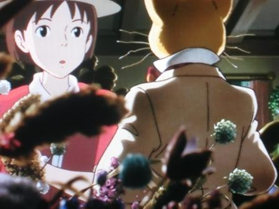 [2002], a prequel]. She learns Seiji also works at the shop downstairs handcrafting violins. Like Shizuku he has grand dreams of becoming a world-class violinmaker. To compensate for lack of bonding on the home front with her busy, disconnected, professional family, Shizuku ends up spending more time with Seiji and his grandfather. The connection grows between Seiji and Shizuku as they share their dreams and love for music. Their friendship prospers and by frequenting the shop The Baron appears in her dreams.
[2002], a prequel]. She learns Seiji also works at the shop downstairs handcrafting violins. Like Shizuku he has grand dreams of becoming a world-class violinmaker. To compensate for lack of bonding on the home front with her busy, disconnected, professional family, Shizuku ends up spending more time with Seiji and his grandfather. The connection grows between Seiji and Shizuku as they share their dreams and love for music. Their friendship prospers and by frequenting the shop The Baron appears in her dreams.
Like any great writer fueled by inspiration, she begins writing about the German cat and incorporating his character into her fanciful world of fantasy. Her writing flourishes and Seiji’s grandfather, as well as Seiji, continue encouraging her development stressing hard word as the key. Seiji’s grandfather shares his own past and how The Baron came to him. The Baron figure is one of a set of two figurines and he too has dreams of reuniting with his unrequited love that possesses the bride, Louise. Akin to any fragile teenage romance, Shizuko’s world delicately hangs in the balance as the forces of those youthful dreams pull them down different paths.
Seiji informs her of fantastic news that has materialized. He is going on a student version of sabbatical to apprentice under the masters of violin craftsmanship in Crimona, Italy. He will be gone for two months and Shizuku’s heart wilts. To make matters more destabilizing to her newfound friendship and love for Seiji, if things go well, his father has agreed to allow him to move to Italy to study and train to be one of the greats.  While Seiji is over the mountain with the news, Shizuku is somewhat tentative in her excitement for Seiji. “That’s great that you know what you want to do with your life. I don’t have a clue what I want to do with mine” she shrinks. [Do some of us ever know?] She learns later it was Seiji who had checked out those books to capture Shizuko’s attention by design and ironically he must now leave her just as he begins to fall in love with her too. When Seiji departs, Shizuko begins voraciously writing Whisper Of The Heart. She is inspired to write by The Baron with Mr. Nishi’s full blessing. Seiji’s grandfather is filled with wisdom for Shizuko’s and is her guiding conscience and moral compass throughout the picture [Harold Gould turns in a vintage performance voicing a calm, wizened, warm, positive role model]. When Shizuko’s grades begin to suffer as she writes, what seems like rebellion is actually her attempt at self-discovery and her desire to find her place in the world. Her parents take her to task, but dad serves up the best ‘sink or swim’ fatherly advice in the world. “Not everyone needs to follow the same path. Do what your heart tells you. But it’s never easy when you do things differently from everyone else. If things don’t go well you’ll only have yourself to blame.” So will Seiji be there as the inspiration Shizuko needs in the end? Will the two consummate their love like so many idealized teenage romances? The film is filled
While Seiji is over the mountain with the news, Shizuku is somewhat tentative in her excitement for Seiji. “That’s great that you know what you want to do with your life. I don’t have a clue what I want to do with mine” she shrinks. [Do some of us ever know?] She learns later it was Seiji who had checked out those books to capture Shizuko’s attention by design and ironically he must now leave her just as he begins to fall in love with her too. When Seiji departs, Shizuko begins voraciously writing Whisper Of The Heart. She is inspired to write by The Baron with Mr. Nishi’s full blessing. Seiji’s grandfather is filled with wisdom for Shizuko’s and is her guiding conscience and moral compass throughout the picture [Harold Gould turns in a vintage performance voicing a calm, wizened, warm, positive role model]. When Shizuko’s grades begin to suffer as she writes, what seems like rebellion is actually her attempt at self-discovery and her desire to find her place in the world. Her parents take her to task, but dad serves up the best ‘sink or swim’ fatherly advice in the world. “Not everyone needs to follow the same path. Do what your heart tells you. But it’s never easy when you do things differently from everyone else. If things don’t go well you’ll only have yourself to blame.” So will Seiji be there as the inspiration Shizuko needs in the end? Will the two consummate their love like so many idealized teenage romances? The film is filled
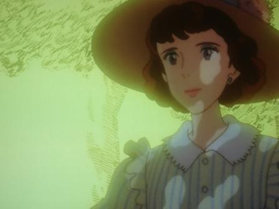 with a number of secondary characters that drive the story like her good friend Yuko. The flamboyantly voiced Baron [over dramatized beautifully by Cary Elwes] shows her the way to a variety of gem-laden paths from which she can choose to realize her dreams. The film is a snapshot of every day living for two young dreamers and in that it is a charming, peaceful film. It’s the kind of young life most welcome and with a little luck have the good fortune to experience.
with a number of secondary characters that drive the story like her good friend Yuko. The flamboyantly voiced Baron [over dramatized beautifully by Cary Elwes] shows her the way to a variety of gem-laden paths from which she can choose to realize her dreams. The film is a snapshot of every day living for two young dreamers and in that it is a charming, peaceful film. It’s the kind of young life most welcome and with a little luck have the good fortune to experience.
The message during those trying years, never lose sight of your dreams, your potential and to actualize goals through action. Shizuku whispers to The Baron, “there’s a sad story there I’ll have to figure it out for myself.” Ultimately it’s a symbolic moment as she in truth speaks of her own personal journey of discovery that must be unearthed. While teen romance is special it can be distracting and sometimes destructive. It’s all in how the heart processes those emotions constructively without selling one short. It’s a stressful time to balance love and desire combined with peer group pressures. Some wander with uncertainty while others are blessed with a focused, relentless drive. There is no formula. Making decisions while in love is difficult and made more complicated by the open whispering heart. Like the cat that lures Shizuko down an unfamiliar path, taking a shot at life despite the unknown is a risk worth taking. Stand down fear. You may go down an unintended road, perhaps the wrong path for a while, but unwittingly it may lead you to the right one eventually. Welcoming the influence of others, like Seiji, has a profound impact on shaping our worldview. External forces combined with the dreams that drive us help define us [nature and nurture rather than nature versus nurture]. Following a dream is a major theme in the film as it often leads to self-worth and identity. After all, dreams sustain human existence and give us hope. They are central to living our lives and there is no better illustration than through the eyes and hearts of the undimmed spirit of the young. Even the young at heart, as Mr. Nishi proves, are never too old to give up on dreams. Yoshifumo Kondo’s portrait of youth may be a throwback to simpler times, but every depiction of emotion visually is sensitive and captures the timeless essence of human nature. Kondo’s spirit and heart have left an indelible mark on this beautiful story.
Whisper Of The Heart is superb. The screenplay is insightfully penned, as one has only come to expect, from Hayao Miyazaki. It seems fitting the story be handed to Yoshifumi Kondo for new direction since it’s mostly free of Miyazaki’s environmental themes or flights of fancy. The one exception is the dream sequence, which Miyazaki orchestrated by enlisting fantasy artist Naohisa Inoue to paint the breathtaking,
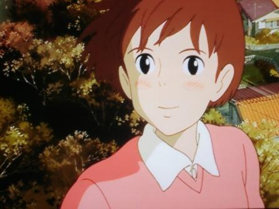 sky-soaring backdrops. It’s a painting come to life. Most of the film is firmly grounded in the realities of life, love and the pain that accompanies maturation. It is a heartfelt Studio Ghibli love letter. It was the perfect opportunity for Miyazaki to step away from the directorial reins and the perfect vehicle to allow Kondo to spread his more than capable, exceptionally talented wings. If anyone could come close to filling the shoes of Miyazaki it was Kondo. It certainly has the idyllic sense of life’s many treasures that can often be found in a Studio Ghibli production. It welcomes the many marvels life has to offer.
sky-soaring backdrops. It’s a painting come to life. Most of the film is firmly grounded in the realities of life, love and the pain that accompanies maturation. It is a heartfelt Studio Ghibli love letter. It was the perfect opportunity for Miyazaki to step away from the directorial reins and the perfect vehicle to allow Kondo to spread his more than capable, exceptionally talented wings. If anyone could come close to filling the shoes of Miyazaki it was Kondo. It certainly has the idyllic sense of life’s many treasures that can often be found in a Studio Ghibli production. It welcomes the many marvels life has to offer.
Studio Ghibli flawlessly delivers another spectacularly fluid production. The cel art does for the cityscape, street signs and shop corners what My Neighbor Totoro did for the country’s pastoral setting. It is a picturesque snapshot of city living. The cellular animation and painstaking studio work you’ve come to expect from preceding Studio Ghibli efforts continues its’ faultless and pristine run. Kondo’s team, with great care, lovingly paints urban and suburban vistas or the intimacy of settings like the sparkling wonder found in the meticulous antique shop. Japanese life is portrayed with exquisite detail. Colors are bright and inviting and every frame looks like a picture postcard thanks to the quality restoration.
Buena Vista Home Entertainment/ Disney distributes a crisp 5.1 audio mix and seems right at home here in teen territory thanks to the heavy rotation of its own Disney Channel. The surround excellence is subtle but welcomed throughout emphasizing Mother Nature’s falling rains, the humming cicadas, the rustling, robust winds found in the fantasy sequence and an illuminating score. The English dub provided by the company is first rate. Departing from the often-associated
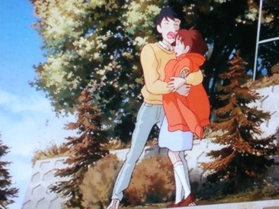 composer Joe Hisaishi for Hayao Miyazaki’s films, Yoshifumi Kondo enlists the talents of Yuji Nomi to score the picture with a steady calmness and tranquility to suit those gentle whispers. The Japanese version of John Denver’s “Country Road” by Yoko Honna has a lovely, light, accessible J-pop quality that strums along nicely at the film’s closing. It’s a swaying delight. The number is played as variations on a theme throughout reminding us of Shizuko’s journey beginning with Olivia Newton-John’s interpretation of the Denver classic.
composer Joe Hisaishi for Hayao Miyazaki’s films, Yoshifumi Kondo enlists the talents of Yuji Nomi to score the picture with a steady calmness and tranquility to suit those gentle whispers. The Japanese version of John Denver’s “Country Road” by Yoko Honna has a lovely, light, accessible J-pop quality that strums along nicely at the film’s closing. It’s a swaying delight. The number is played as variations on a theme throughout reminding us of Shizuko’s journey beginning with Olivia Newton-John’s interpretation of the Denver classic.
In the end, this is the singular entry by Yoshifumi Kondo, a unique artist whose heart shone brightly and all too briefly. It is the underappreciated gentle story of a tender age by one of the studio’s premier talents. This was a man so gifted he was destined the heir apparent to the Studio Ghibli fortunes led by Miyazaki and Takahata. He was the artistic leadership of a second generation for the studio, the logical successor to Miyazaki and Takahata who were clearly heading into the twilight of their careers. One thing is certain, Whisper Of The Heart is proof positive that Kondo was a significant pulse within the studio and his presence is highly noteworthy. Otaku and studio colleagues alike would sorely miss his presence. Kondo was one of those rare talents who captured the vitality and beauty of animation and combined it with a real touch of magic and humanity that is a trademark at Studio Ghibli. He was an extraordinary find. His singular directorial accomplishment is simple and straightforward, beautiful and bittersweet when considering what might have been for this fine director. His animated heart will be seen for years to come thanks to this delightful film and the films he touched along the way on his own sweet journey.
